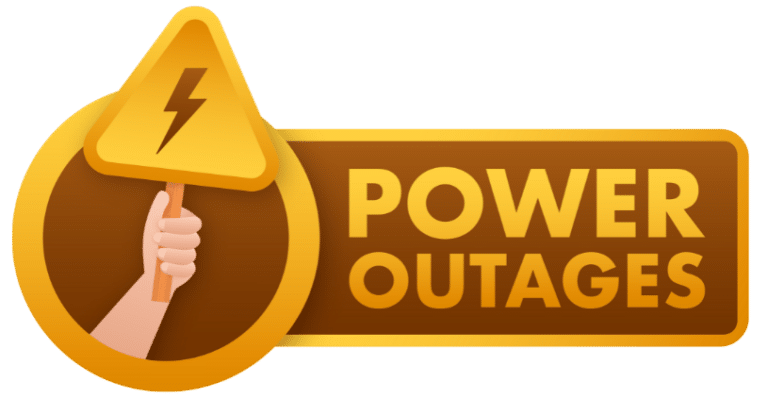POWer Outage Preparedness

Power Outage Preparedness – Know Exactly What to do
A power outage can strike at any time, leaving you without electricity and disrupting your daily routine. Whether it’s due to a severe storm, electrical fault, or maintenance work, power outages can be inconvenient and even dangerous if you’re unprepared. That’s why it’s essential to take the necessary steps to ensure you’re ready for such situations.
In this article, we’ll discuss power outage preparedness and the essential steps you should take when disaster strikes. From creating an emergency kit to knowing when it is to call a licensed electrician – JVK Electrical on 0410 689 029. We’ll cover everything you need to know to stay safe and minimise the impact of power outages. So, if you’re wondering what to do when the lights go out, keep reading!
1. The importance of power outage preparedness
In today’s fast-paced world, we heavily rely on electricity to power our homes, businesses, and daily activities. However, power outages are unpredictable and can happen at any moment. That’s why being prepared for such situations is crucial.
One of the main reasons why preparing for a power outage is important is the impact it can have on our safety. When the lights go out, our homes become dark, making it difficult to move around and navigate through the surroundings. This increases the risk of accidents, especially for children and elderly individuals.
Additionally, electrical failures can disrupt essential services such as heating, cooling, and refrigeration, which are vital for our comfort and well-being. They can also lead to the loss of perishable food items, compromising our health and adding unnecessary expenses.
Furthermore, a power outage can affect our communication systems, making it challenging to reach emergency services or stay in touch with our loved ones. This can be particularly concerning during severe weather events or other emergencies when reliable communication is crucial.
By taking the necessary steps to prepare for a blackout, you can decrease these risks and inconveniences. You can ensure the safety of your family, preserve essential services, and stay connected with emergency assistance if needed.
In the next section, we will delve into the specific steps you can take to be better prepared for power outages. From assembling an emergency kit to implementing backup power solutions, we’ll cover everything you need to know to effectively navigate through these challenging situations. So, let’s get started!
2. Assessing your power needs
Assessing your power needs is a crucial step in preparing for a power outage. Understanding your electrical requirements will help you determine what backup power solutions are necessary for your specific situation.
Start by identifying the essential appliances and systems in your home or business that require electricity to function. This may include lights, heating or cooling systems, refrigeration units, medical equipment, or communication devices.
Once you have identified these vital power sources, consider the duration of power outages in your area. If outages tend to be short-lived, investing in alternative lighting sources such as flashlights or candles may be sufficient. However, for longer outages, you may need to explore options such as portable generators or solar power systems.
It’s also important to research and understand the electricity requirements of the backup power solutions you are considering. This will help you determine if they are compatible with your specific power needs.
By accurately assessing your electrical needs, you can confidently choose the right backup solutions that will keep you and your loved ones safe and comfortable during a power outage.
3. Creating a backup power plan
Creating a backup power plan is an essential step in being prepared. Once you have assessed your electrical needs and identified the necessary backup power solutions, it’s time to create a comprehensive plan to ensure a smooth transition during electrical failure.
Start by designating a specific location for your backup power equipment. This area should be easily accessible and well-ventilated to prevent any potential hazards. Additionally, ensure that all members of your household or employees are aware of this designated area and understand how to safely use the backup power equipment.
Next, develop a clear communication plan. This should include important contact numbers for utility companies, emergency services, and neighbours who may be able to assist during an outage. Additionally, consider establishing a designated meeting point outside your home or business in case evacuation becomes necessary.
Regularly test your backup power equipment to ensure it is functioning properly. This will give you the confidence that your backup power plan is reliable and ready to use when needed.
By creating a backup power plan, you can reduce the impact of power outages and maintain a sense of normalcy during these challenging times.
4. Essential supplies for your power outage kit
In addition to creating a backup power plan, it is important to have an emergency kit stocked with essential supplies. These supplies will help you and your family or employees stay safe and comfortable during a power outage.
Firstly, make sure to have an ample supply of non-perishable food and drinking water. Aim for at least a three-day supply for each person. Include items such as canned goods, dry snacks, and bottled water. Don’t forget a manual can opener!
Next, include necessary items for personal hygiene. Pack items such as toothbrushes, toothpaste, hand sanitiser, wet wipes, and toilet paper. It is also wise to have a basic first aid kit on hand in case of any minor injuries.
Keep a few flashlights or battery-powered lanterns in your kit, along with extra batteries. These will provide much-needed light during the outage. Additionally, consider including a portable radio to stay updated on any safety information or evacuation alerts.
Lastly, have a supply of blankets, warm clothing, and extra batteries for any medical devices that may be reliant on electricity.
By having these essential supplies in your emergency kit, you will be better prepared to navigate through any unforeseen circumstances during a power outage.
5. Implementing safety measures during a power outage
When a power outage strikes, it is crucial to implement safety measures to protect yourself and others. Firstly, turn off and unplug any electrical appliances or devices to avoid power surges or damage when the power is restored. This will also prevent potential fire hazards.
Be cautious when using candles for lighting, as they can pose a fire risk. Instead, rely on flashlights or battery-powered lanterns as much as possible.
If you plan to use a generator, ensure it is placed outdoors in a well-ventilated area, away from windows, doors, and vents to prevent carbon monoxide poisoning.
Stay away from downed power lines and report them to the local authorities. Treat all downed lines as live and dangerous.
Lastly, conserve your battery-powered devices and use them sparingly to preserve their power. Communication is essential during emergencies, so prioritise using your devices for important updates and emergency calls only.
By implementing these safety measures, you can limit the risks associated with power outages and ensure the well-being of yourself and those around you.
6. Communicating with employees and customers during a power outage
In the event of an electrical failure, effective communication becomes even more vital to ensure the smooth running of your business and the safety of your employees and customers.
To begin with, establish a communication plan before disaster strikes. This includes creating an updated contact list of all employees, along with their phone numbers, email addresses, and any other relevant information. Ensure that this list is easily accessible to everyone in your organisation.
During a power outage, use alternative communication methods to stay in touch with your employees. This may involve sending regular email updates or using messaging apps or social media platforms to provide important updates, such as office closures or shifting work arrangements.
Additionally, it is essential to communicate with your customers and clients, notify them about any disruptions to your services, and inform them of alternative ways to reach out to your business. Utilise social media platforms or automated phone messages to keep your customers informed and reassured about their interaction with your company.
Remember, clear and timely communication is key to minimising confusion and maintaining relationships during a power outage. By taking proactive steps and staying in touch, you can ensure that everyone remains informed and safe during challenging times.
7. Regular maintenance and testing of backup power systems
Regular maintenance and testing of backup power systems is crucial to ensure that they are ready to perform when a power outage occurs. This includes checking the condition of the backup power units, such as generators or uninterruptible power supply (UPS) systems, and scheduling routine maintenance to address any potential issues.
It is important to have qualified technicians inspect and service these systems periodically to ensure they are in proper working order. This may involve testing the functionality of the backup power systems, replacing worn-out parts, and checking fuel levels or battery capacities.
In addition, establish a schedule for conducting regular tests of the backup power systems. This will help identify any unforeseen issues and allow time for repairs or adjustments before a power outage actually occurs. Consider running these tests during non-peak hours or when minimal disruption to business operations is expected.
By prioritising regular maintenance and testing of backup power systems, you can increase the reliability and effectiveness of these systems during a power outage. This will reduce downtime, ensure the safety of your employees, and prevent any potential damage to critical equipment or data.
8. Be prepared and stay safe during power outages
The key to navigating power outages successfully is being prepared. By following the essential steps mentioned in this article, you can guarantee that you and your business are ready when disaster strikes. Ensuring the safety of your employees and protecting critical equipment and data.
For a Clarence Valley or Gold Coast electrician you can count on, get in touch with Jay at JVK Electrical and Air Conditioning on 0410 689 029. We are the emergency electricians the locals can rely on.









